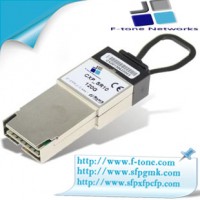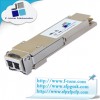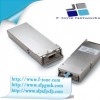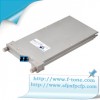标准光模块

CXP-120G-SR12
Specifications
- 产品型号: CXP-120G-SR12
- 兼容品牌: 全系列
- 封装类型: CXP
- 传输速率: 120G
- 传输距离: 300m on OM3 or 400m on OM4
- 发射波长: 850nm
- 接收波长: 850nm
- 工作温度: 商业级0℃~+70℃/工业级-40℃~+85℃ 可选
- 数字诊断: 带DDM
- 接收灵敏度: 300m on OM3 or 400m on OM4
- 接收灵敏度: 300m on OM3 or 400m on OM4
Description
CXP-120G-SR12 Optical Transceiver module
Features
- 12-channel full-duplex transceiver module
- Hot Pluggable CXP footprint
- Maximum link length of 300m on OM3 or 400m on OM4 Multimode Fiber (MMF)
- Multirate capability: 1.06Gb/s to 10.5Gb/s per channel
- Unretimed CPPI electrical interface
- Requires 3.3V power supply only
- Low power dissipation: <3.5W
- Reliable VCSEL array technology
- Built-in digital diagnostic functions
- Commercial operating case temperature range: 0°C to 70°C
- Single MPO connector receptacle
- RoHS-6 Compliant (lead-free)
Applications
- 100GBASE-SR10 100G Ethernet
- Multiple 1G/2G/4G/8G/10G Fibre Channel
- Infiniband transmission at 12ch SDR, DDR and QDR
- Switches, Routers
- Data Centers
- Other 120G Interconnect Requirement
Description
F-tone’s CXP-120G-SR12 CXP transceiver modules is a high performance, low power consumption, long reach interconnect solution supporting 100G Ethernet, InfinibandQDR,DDR,SDR,1G/2G/4G/8G/10Gfiber channel and PCIe. It is compliant with the 120Gbits Small Form factor Hot-Pluggable CXP-interface. F-tone’s CXP transceiver modules is an assembly of 12 full-duplex lanes, where each lane is capable of transmitting data at rates up to 10.5Gb/s, providing an aggregated rate of 120Gb/s.
General Product Characteristics
|
Parameter |
Value |
Unit |
Note |
|
Module Form Factor |
CXP |
||
|
Number of Lanes |
12 Tx and 12 Rx |
||
|
Maximum Aggregate Data Rate |
126 |
Gb/s |
|
|
Maximum Data Rate per Lane |
10.5 |
Gb/s |
|
|
Protocols Supported |
Typical applications include 100G Ethernet, Infiniband, Fibre Channel, SATA/SAS3 |
||
|
Electrical Interface and Pin-out |
84-pin edge connector |
Pin-out as defined by the CXP Specification |
|
|
Optical Cable Type Required |
Multimode ribbon 24-fiber cable assembly, MPO connector |
||
|
Maximum Power Consumption per End |
3.5 |
Watts |
Varies with output voltage swing and pre-emphasis settings |
|
Management Interface |
Serial, I2C-based, 450 kHz maximum frequency |
As defined by the CXP Specification |
Absolute Maximum Ratings
|
Parameter |
Symbol |
Min |
Max |
Unit |
|
Supply Voltage |
Vcc |
-0.3 |
3.6 |
V |
|
Input Voltage |
Vin |
-0.3 |
Vcc+0.3 |
V |
|
Storage Temperature |
Tst |
-20 |
85 |
ºC |
|
Case Operating Temperature |
Top |
0 |
70 |
ºC |
|
Humidity(non-condensing) |
Rh |
5 |
95 |
% |
Recommended Operating Conditions
|
Parameter |
Symbol |
Min |
Typical |
Max |
Unit |
|
Supply Voltage |
Vcc |
3.13 |
3.3 |
3.47 |
V |
|
Operating Case temperature |
Tca |
0 |
70 |
ºC |
|
|
Data Rate Per Lane |
fd |
1.06 |
10.5 |
Gbps |
|
|
Humidity |
Rh |
5 |
85 |
% |
|
|
Power Dissipation |
Pm |
3.5 |
W |
Specifications
|
Parameter |
Symbol |
Min |
Typical |
Max |
Unit |
|
Differential input impedance |
Zin |
90 |
100 |
110 |
ohm |
|
Differential Output impedance |
Zout |
90 |
100 |
110 |
ohm |
|
Differential input voltage amplitude aAmplitude |
ΔVin |
200 |
1200 |
mVp-p |
|
|
Differential output voltage amplitude |
ΔVout |
600 |
800 |
mVp-p |
|
|
Skew |
Sw |
300 |
ps |
||
|
Bit Error Rate |
BR |
E-12 |
|||
|
Input Logic Level High |
VIH |
2.0 |
VCC |
V |
|
|
Input Logic Level Low |
VIL |
0 |
0.8 |
V |
|
|
Output Logic Level High |
VOH |
VCC-0.5 |
VCC |
V |
|
|
Output Logic Level Low |
VOL |
0 |
0.4 |
V |
Note:
- BER=10^-12; PRBS 2^31-1@10.3125Gbps.
2. Differential input voltage amplitude is measured between TxnP and TxnN
3. Differential output voltage amplitude is measured between RxnP and RxnN.
Electrical Characteristics (TOP = 0 to 70℃, VCC = 3.3 ± 5% Volts)
NOTE: The CXP-120G-SR12 requires that a CPPI-compliant CXP electrical connector be used on the host board in order to guarantee its electrical interface specification. Please check with your connector supplier.
|
Parameter |
Symbol |
Min |
Typical |
Max |
Unit |
Ref. |
|
Supply Voltag |
Vcc1, VccTx, VccRx |
3.15 |
3.3 |
3.45 |
V |
|
|
Supply Current |
Icc |
950 |
1050 |
mA |
||
|
Module Total Power |
P |
3.5 |
W |
1 |
||
|
Link Turn-On Time |
||||||
|
Transmit turn-on time |
2000 |
ms |
2 |
|||
|
Transmitter (per Lane) |
||||||
|
Single ended input voltage tolerance |
VinT |
-0.3 |
4.0 |
V |
||
|
Differential data input swing |
Vin,pp |
120 |
1200 |
mVpp |
3 |
|
|
Differential input threshold |
50 |
mV |
||||
|
AC common mode input voltage tolerance (RMS) |
15 |
mV |
||||
|
Differential input return loss |
Per IEEE 802.3ba, Section 86A.4.1.1 |
dB |
4 |
|||
|
J2 Jitter Tolerance |
Jt2 |
0.17 |
UI |
|||
|
J9 Jitter Tolerance |
Jt9 |
0.29 |
UI |
|||
|
Data Dependent Pulse Width Shrinkage |
DDPWS |
0.07 |
UI |
|||
|
Eye mask coordinates {X1, X2 Y1, Y2} |
0.11, 0.31 95, 350 |
UI mV |
5 |
|||
|
Receiver (per Lane) |
||||||
|
Single-ended output voltage |
-0.3 |
4.0 |
V |
|||
|
Differential data output swing |
Vout,pp |
0 |
800 |
mVpp |
6,7 |
|
|
AC common mode output voltage (RMS) |
7.5 |
mV |
||||
|
Termination mismatch at 1 MHx |
5 |
% |
||||
|
Differential output return loss |
Per IEEE 802.3ba, Section 86A.4.2.1 |
dB |
4 |
|||
|
Common mode output return loss |
Per IEEE 802.3ba, Section 86A.4.2.2 |
dB |
4 |
|||
|
Output transition time, 20% to 80% |
28 |
ps |
||||
|
J2 Jitter output |
Jo2 |
0.42 |
UI |
|||
|
J9 Jitter output |
Jo9 |
0.65 |
UI |
|||
|
Eye mask coordinates {X1, X2 Y1, Y2} |
0.29, 0.5 150, 425 |
UI mV |
5 |
|||
|
Power Supply Ripple Tolerance |
PSR |
50 |
mVpp |
|||
Notes:
1. Maximum total power value is specified across the full temperature and voltage range.
2. From power-on and end of any fault conditions.
3. After internal AC coupling. Self-biasing 100 Ohm differential input.
4. 10 MHz to 11.1 GHz range
5. Hit ratio = 5 x 10E-5
6. AC coupled with 100 Ohm differential output impedance.
7. Settable in 4 discrete steps via the I2C interface. See Figure 2 for Vout settings.
Optical Characteristics (TOP = 0 to 70℃, VCC = 3.3 ± 5% Volts)
|
Parameter |
Symbol |
Min |
Typical |
Max |
Unit |
Ref. |
||
|
Transmitter (per Lane) |
||||||||
|
Signaling Speed per Lane |
10.5 |
GBd |
1 |
|||||
|
Center wavelength |
840 |
860 |
nm |
|||||
|
RMS Spectral Width |
SW |
0.65 |
nm |
|||||
|
Average Launch Power per Lane |
TXPx |
-7.6 |
2.4 |
dBm |
||||
|
Transmit OMA per Lane |
TxOMA |
-5.6 |
3.0 |
dBm |
2 |
|||
|
Difference in Power between any two lanes [OMA] |
DPx |
4.0 |
dB |
|||||
|
Peak Power per Lane |
PPx |
4.0 |
dBm |
|||||
|
Launch Power [OMA] minus TDP per Lane |
P-TDP |
-6.5 |
dBm |
|||||
|
TDP per Lane |
TDP |
3.5 |
dBm |
|||||
|
Optical Extinction Ratio |
ER |
3.0 |
dB |
|||||
|
Optical Return Loss Tolerance |
ORL |
12 |
dB |
|||||
|
Encircled Flux |
FLX |
> 86% at 19 um < 30% at 4.5 um |
dBm |
|||||
|
Average launch power of OFF transmitter, per lane |
-30 |
dBm |
||||||
|
Relative Intensity Noise |
RIN |
-128 |
dB/Hz |
3 |
||||
|
Transmitter eye mask definition {X1, X2, X3, Y1, Y2, Y3} |
0.23, 0.34, 0.43, 0.27, 0.35, 0.4 |
|||||||
|
Receiver (per Lane) |
||||||||
|
Signaling Speed per Lane |
10.5 |
GBd |
4 |
|||||
|
Center wavelength |
840 |
860 |
nm |
|||||
|
Damage Threshold |
DT |
3.4 |
dBm |
|||||
|
Average Receive Power per Lane |
RXPx |
-9.5 |
2.4 |
dBm |
||||
|
Receive Power (OMA) per Lane |
RxOMA |
3.0 |
dBm |
|||||
|
Stressed Receiver Sensitivity (OMA) per Lane |
SRS |
-5.4 |
dBm |
|||||
|
Peak Power, per lane |
PPx |
4 |
dBm |
|||||
|
Receiver Reflectance |
Rfl |
-12 |
dB |
|||||
|
Vertical eye closure penalty, per lane |
1.9 |
dB |
||||||
|
Stressed eye J2 jitter, per Lane |
0.3 |
UI |
||||||
|
Stressed eye J9 jitter, per Lane |
0.47 |
UI |
||||||
|
OMA of each aggressor lane |
-0.4 |
dBm |
||||||
|
Receiver jitter tolerance [OMA], per Lane |
-5.4 |
dBm |
||||||
|
Rx jitter tolerance: Jitter frequency |
(75, 5) |
kHz, UI |
||||||
|
and p-p amplitude |
(375, 1) |
kHz, UI |
||||||
|
LOS De-Assert |
LOSD |
-11 |
dBm |
|||||
|
LOS Assert |
LOSA |
-14 |
dBm |
|||||
|
LOS Hysteresis |
1 |
dB |
||||||
Notes:
1. Transmitter consists of 12 lasers operating at a maximum rate of 10.5Gb/s each.
2. Even if TDP is <0.9dB, the OMA min must exceed this value.
3. RIN is scaled by 10*log (10/4) to maintain SNR outside of transmitter.
4. Receiver consists of 12 photodetectors operating at a maximum rate of 10.5Gb/s each.





